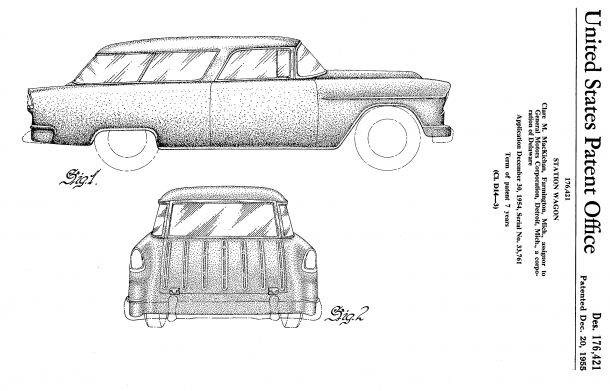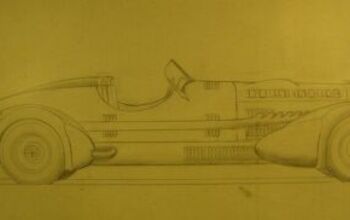Designers and Their Cars - Automotive Patent Art Revisited

A Brooks Stevens concept.
Aaron Cole’s post about automotive patent art gladdened my heart. Years ago, I decided to check out some of Les Paul and Leo Fender’s original patents on their electric guitars and I discovered the artistry of patent drawings. These days the United States Patent and Trademark Office, as well as patent offices around the world, accept digitally produced artwork. However, before the digital age, an inventor had to hire someone skilled at technical drawing to produce the various exploded and see-through sketches needed to describe the “preferred embodiment” of a process patent.
Of course the “inventor” of a design patent — a slightly different form of intellectual property that protects the design and look of a product — is more often than not, the actual designer.
Following up on Aaron’s post, I decided to put the names of some notable automotive designers into a patent search engine to see what I could find. My hypothesis was that in the case of a design patent, particularly for a car, the artwork for the patent application was likely to have been drawn by the designer. A patent is a big deal to any engineer or designer and he’d likely want to be the one responsible for representing his own idea best.
Clare MacKichan’s Chevy Nomad
Yes, sometimes the boss takes credit for subordinates’ work. Harley Earl, General Motors’ first head of styling, was known not to draw very well. Designers and clay modelers working for him, though, said he had a masterful way of waving his hands that communicated well to the designers the vision he had in his mind’s eye. Car design is a collaborative process, involving people you work with and work for. Guys like Earl, his successor Bill Mitchell, or carrozzeria boss Nuccio Bertone had some justification in putting their names on patents, even if they only had supervisory roles.
Car body designed by Harley Earl in 1921 when he was still working for his father’s custom body shop in Los Angeles, before he was hired by Alfred Sloan to start GM’s styling department in 1927.
Next to lead designer Hank Haga’s name, the Chevrolet Aerovette patent carries Mitchell’s name along with that of senior designer Chuck Jordan (who succeeded Mitchell as head of GM Design) as well as GM designer Jerry Palmer. A similar situation exists with the current Mustang convertible, whose patent bears Ford design chief J Mays’ name along with those of designers Moray S. Callum, Joel Piaskowski, Darrell Behmer, and Kemal Curic.
A Ray Dietrich design.
I’m willing to guess that even if Earl, Mitchell or Mays didn’t render the patent drawings themselves, they assigned a senior designer with the task of their posterity, not some intern. Regardless of who did the actual drawings, they were very well executed.
Enjoy:
Eugene “Bob” Gregorie was Ford’s first head of styling.
One of Virgil Exner Sr’s Chrysler-Ghia show cars.
Harley Earl’s name is on this Cadillac design from the early 1950s.
This Motorama concept, called L’Universelle, was a front wheel drive passenger van designed by Chuck Jordan.
One of Ian Callum’s Jaguars
A more recent, digitally rendered Jaguar
Marcello Gandini’s Lamborghini Diablo
Giorgetto Giugiaro’s DeLorean DMC12, an update of an earlier design of his.
JB’s editors at R&T might think that Paul Bracq designed the BMW M1, but it’s Giugiaro’s name on the design patent. Bracq did the BMW Turbo, on which the M1 was based.
Aerovette.
Art Ross, who headed Cadillac and Oldsmobile’s studios, rendered the Golden Rocket Motorama car
Raymond Loewy coupe concept from the early 1960s.
One of Virgil Exner Sr’s last cars for Chrysler.
A Corvair concept by Larry Shinoda.
One of Bill Mitchell’s Corvette concepts, perhaps the Mako Shark.
Camilo Pardo’s Ford GT
The current Ford Mustang
Ronnie Schreiber edits Cars In Depth, a realistic perspective on cars & car culture and the original 3D car site. If you found this post worthwhile, you can get a parallax view at Cars In Depth. If the 3D thing freaks you out, don’t worry, all the photo and video players in use at the site have mono options. Thanks for reading – RJS

Ronnie Schreiber edits Cars In Depth, the original 3D car site.
More by Ronnie Schreiber
Latest Car Reviews
Read moreLatest Product Reviews
Read moreRecent Comments
- 3SpeedAutomatic 2012 Ford Escape V6 FWD at 147k miles:Just went thru a heavy maintenance cycle: full brake job with rotors and drums, replace top & bottom radiator hoses, radiator flush, transmission flush, replace valve cover gaskets (still leaks oil, but not as bad as before), & fan belt. Also, #4 fuel injector locked up. About $4.5k spread over 19 months. Sole means of transportation, so don't mind spending the money for reliability. Was going to replace prior to the above maintenance cycle, but COVID screwed up the market ( $4k markup over sticker including $400 for nitrogen in the tires), so bit the bullet. Now serious about replacing, but waiting for used and/or new car prices to fall a bit more. Have my eye on a particular SUV. Last I checked, had a $2.5k discount with great interest rate (better than my CU) for financing. Will keep on driving Escape as long as A/C works. 🚗🚗🚗
- Rna65689660 For such a flat surface, why not get smoke tint, Rtint or Rvynil. Starts at $8. I used to use a company called Lamin-x, but I think they are gone. Has held up great.
- Cprescott A cheaper golf cart will not make me more inclined to screw up my life. I can go 500 plus miles on a tank of gas with my 2016 ICE car that is paid off. I get two weeks out of a tank that takes from start to finish less than 10 minutes to refill. At no point with golf cart technology as we know it can they match what my ICE vehicle can do. Hell no. Absolutely never.
- Cprescott People do silly things to their cars.
- Jeff This is a step in the right direction with the Murano gaining a 9 speed automatic. Nissan could go a little further and offer a compact pickup and offer hybrids. VoGhost--Nissan has laid out a new plan to electrify 16 of the 30 vehicles it produces by 2026, with the rest using internal combustion instead. For those of us in North America, the company says it plans to release seven new vehicles in the US and Canada, although it’s not clear how many of those will be some type of EV.Nissan says the US is getting “e-POWER and plug-in hybrid models” — each of those uses a mix of electricity and fuel for power. At the moment, the only all-electric EVs Nissan is producing are the Ariya SUV and the perhaps endangered (or maybe not) Leaf.In 2021, Nissan said it would make 23 electrified vehicles by 2030, and that 15 of those would be fully electric, rather than some form of hybrid vehicle. It’s hard to say if any of this is a step forward from that plan, because yes, 16 is bigger than 15, but Nissan doesn’t explicitly say how many of those 16 are all-battery, or indeed if any of them are. https://www.theverge.com/2024/3/25/24111963/nissan-ev-plan-2026-solid-state-batteries



























































































































Comments
Join the conversation
Very interesting article. What you should know is that it is highly unlikely that any of the aforementioned auto designers actually penned these patent drawings. Note that the US Patent and Trademark Office has very stringent requirements regarding drawings ( https://www.law.cornell.edu/cfr/text/37/1.84 ), and that it's likely that the designer couldn't be bothered to familiarize himself with such requirements and prepare a set of PTO-compliant drawings, in addition to the drawings required by his boss(es). Peace Out, ChiefPontiaxe, registered patent attorney.
Note that when an element is shown in hatched/phantom lines, it means that that element does not form part of the invention, which is why most auto design patents show the wheels in hatched/phantom lines. Otherwise, the patentee would be limited to the vehicle/wheel combination shown in the design patent, and making it easier for an accused infringer to avoid infringement by changing the wheels of the accused vehicle.